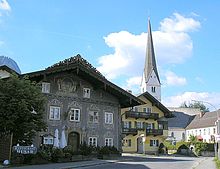Im Winkl (Garmisch-Partenkirchen)
The core of the settlement Im Winkl in Garmisch comprises several historic streets in the Upper Bavarian market of Garmisch-Partenkirchen . Parts of the streets Im Winkl, Fürstenstraße, Pfarrhausweg and Burgstraße are an ensemble on the basis of the Monument Protection Act of October 1, 1973, the file number is E-1-80-117-9.
description
The first two settlement centers in Garmisch were separated by the Loisach . The Im Winkl ensemble comprises the northern core of the settlement, which touches the old traffic route to Werdenfels Castle and on to Murnau am Staffelsee to the east . This old traffic route exists in Garmisch today in the form of Burgstrasse. The town center developed around the old parish church of St. Martin , the mother church for the entire upper Loisach and Isar valleys . The Im Winkl ensemble forms a narrowly delimited quarter of particular historical density. In contrast to the area south of the Loisach, which expanded much more and became the actual center of the village with the construction of the baroque parish church .
Martinskirche, built around 1280 instead of a Romanesque predecessor, stands at the highest point of the terrain, which rises slightly from the river crossing. It is surrounded by a former cemetery, an essentially baroque parsonage with an economy, the old sacristan's house and the old school attached to the south of the church in 1853. From the staggered development on the west side of Fürstenstrasse towards the church, the large steep-gable building of the former Rentamt and the Haus zum Husaren , with its rich facade decoration, date back to the 17th century.
In the early 20th century, on the site of the old brewery and on the site of a former rural property, buildings were built in the form of the alpine homeland style that respected the architectural lines and standards of the baroque predecessor buildings. The design of these houses increases the picturesque charm of the streetscape even more. The Bräustüberl as well as the parsonage were redesigned in 1934/36, with Heinrich Bickel's murals addressing the historical reference to the place and at the same time following the tradition of Lüftlmalerei. The new school building (Burgstrasse 9) built in 1907/1908 below the choir of St. Martin in baroque Art Nouveau forms the modern counterpart to the schoolhouse from 1853; it also marks the north-eastern boundary of the ensemble.
The beginning of the ensemble from the south is a commercial building built in 1927. The rural settlement of Im Winkl extends in a depression east of Fürstenstrasse. This development is characterized by closely spaced farmhouses, whereby the houses on Fürstenstrasse with their ornamental gables, some of which go back to the 18th century, widen like a square. The former farm properties, which, like many houses in Garmisch, were converted into residential houses in the 1920s and 30s, are loosely arranged to the east of Im Winkl.
See also
literature
- Wilhelm Neu, Volker Liedke: Upper Bavaria . Ed .: Michael Petzet , Bavarian State Office for the Preservation of Monuments (= Monuments in Bavaria . Volume I.2 ). Oldenbourg, Munich 1986, ISBN 3-486-52392-9 .
Web links
- Bavarian Monument Atlas (cartographic representation of the Bavarian architectural and ground monuments by the Bavarian State Office for Monument Preservation (BLfD) )
Coordinates: 47 ° 29 ′ 33.2 ″ N , 11 ° 5 ′ 3.2 ″ E
